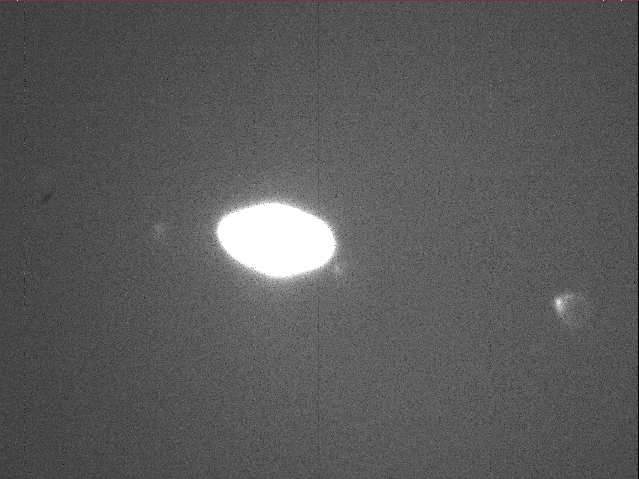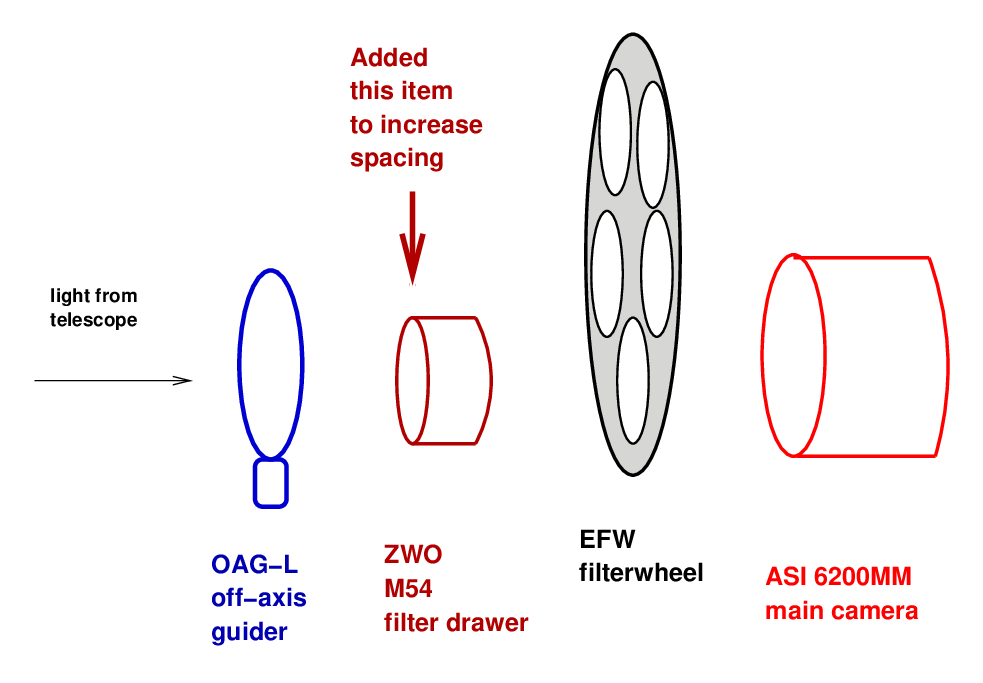
In the early morning hours of Jul 14/15, 2022, under good conditions, I ran some tests and made adjustments for an autoguider on the 12-inch telescope. It wasn't very exciting, but I think I've figured out how to get past a sticking point.
Executive summary:
The goal is to be able to take images with the new ASI 6200MM camera on the 12-inch telescope, and, at the same time, use a second camera for autoguiding. I've been trying to figure out how to connect a second camera to the ASI system in the proper manner. The tough part was achieving simultaneous focus with the guide camera and the main camera. In tests on previous nights, the guide camera could not be moved inwards, towards the telescope, far enough to reach focus.
This morning, I removed the Orion eyepiece-projection unit that I had been using to hold the guide camera ( Orion StarShoot Autoguider Pro Mono ), and tried inserting the guide camera directly into the short slide tube of the ZWO OAG-L off-axis guider. However, even after sliding the guide camera as far into this slide tube as possible, it was still slightly beyond the focus position. Using the electric focuser to move between positions at which main camera was in focus, and guide camera was in focus, revealed the extra distance needed was 0.2 inches = 5 mm.
Here's an image of Saturn and its moons taken at 08:53 UT. Titan is the bright moon at right side, Rhea the faint object just to the right of the rings, Dione the object just to the left of the rings, and Iapetus the very faint blob just above the dark image defect at left edge of screen. North is up, East to left, field of view is about 5.7 x 4.3 arcminutes, with a plate scale of 0.26 arcsec per pixel.

This is a 1-second exposure with no filter, taken at an airmass of about 2.0. The fact that tenth-magnitude objects can be seen, even so far from focus, is a good sign for the future.
In order to achieve this standard orientation of North-up, East-left, one must place the guider camera into the OAG-L slidetube so that the guide camera's USB port is closest to the telescope; or, as viewed from the normal park position with telescope vertical, the USB port should be vertically upward above the center of the camera. The phone jack port should be vertically below the USB port (far from the telescope). With that orientation, in MaximDL, use camera settings
In order to gain this extra 5 mm, after the run was over, I added one item to the camera's suite of hardware. I inserted a ZWO M54 filter drawer between the OAG-L unit and the EFW filterwheel. This should add about 20 mm of distance between the guider and the main camera, which means it ought to be possible to have plenty of room for adjusting focus. I'll try that on the next clear night.

I also determined that the guider field is located just outside the main camera's field to the West (at right-hand side of the TV screen showing the finder's field of view). Using Saturn as a marker, I roughly centered it in the main camera's field, read the RA and Dec position of the telescope, and then slewed West until Saturn was roughly centered in the guider. The offset was 22 arcminutes.
MaximDL complained with error message Could not initialize guider output. Please check guider settings every time I took an image with the guide camera. Eventually, I figured out that I ought to modify the guider settings in MaximDL. The values had been set to "LX200 Protocol" and "COM4". I tried changing the port to "COM1", and the error messages stopped. However, I didn't actually tell MaximDL to move the telescope, so it's not certain that this is the proper setting. Must test this on another night.
Last modified 7/15/2022 by MWR.